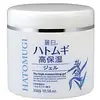What's inside
What's inside
 Key Ingredients
Key Ingredients

No key ingredients
 Benefits
Benefits

 Concerns
Concerns

 Ingredients Side-by-side
Ingredients Side-by-side

Hippophae Rhamnoides Water
MaskingGlycerin
HumectantButylene Glycol
HumectantCaprylic/Capric Triglyceride
MaskingBetaine
HumectantHelianthus Annuus Seed Oil
EmollientCetearyl Alcohol
EmollientCetearyl Olivate
Sorbitan Olivate
EmulsifyingMacadamia Ternifolia Seed Oil
Emollient1,2-Hexanediol
Skin ConditioningSodium Hyaluronate
HumectantArginine
MaskingPanthenol
Skin ConditioningDimethicone
EmollientEthylhexylglycerin
Skin ConditioningCarbomer
Emulsion StabilisingAllantoin
Skin ConditioningXanthan Gum
EmulsifyingHippophae Rhamnoides Water, Glycerin, Butylene Glycol, Caprylic/Capric Triglyceride, Betaine, Helianthus Annuus Seed Oil, Cetearyl Alcohol, Cetearyl Olivate, Sorbitan Olivate, Macadamia Ternifolia Seed Oil, 1,2-Hexanediol, Sodium Hyaluronate, Arginine, Panthenol, Dimethicone, Ethylhexylglycerin, Carbomer, Allantoin, Xanthan Gum
Water
Skin ConditioningGlycerin
HumectantButylene Glycol
HumectantDipropylene Glycol
HumectantTriethylhexanoin
MaskingDiphenyl Dimethicone
EmollientPolyglyceryl-10 Myristate
Skin ConditioningPEG-60 Hydrogenated Castor Oil
EmulsifyingCarbomer
Emulsion StabilisingPEG-Crosspolymer
Vigna Radiata Seed Extract
Skin ConditioningIsomerized Safflower Acid
Skin ConditioningSoluble Collagen
HumectantHydrolyzed Collagen
EmollientSuccinic Acid
BufferingDisodium EDTA
Sodium Hydroxide
BufferingCitric Acid
BufferingPhenoxyethanol
PreservativeMethylparaben
PreservativeWater, Glycerin, Butylene Glycol, Dipropylene Glycol, Triethylhexanoin, Diphenyl Dimethicone, Polyglyceryl-10 Myristate, PEG-60 Hydrogenated Castor Oil, Carbomer, PEG-Crosspolymer, Vigna Radiata Seed Extract, Isomerized Safflower Acid, Soluble Collagen, Hydrolyzed Collagen, Succinic Acid, Disodium EDTA, Sodium Hydroxide, Citric Acid, Phenoxyethanol, Methylparaben
 Reviews
Reviews

Ingredients Explained
These ingredients are found in both products.
Ingredients higher up in an ingredient list are typically present in a larger amount.
Butylene Glycol (or BG) is used within cosmetic products for a few different reasons:
Overall, Butylene Glycol is a safe and well-rounded ingredient that works well with other ingredients.
Though this ingredient works well with most skin types, some people with sensitive skin may experience a reaction such as allergic rashes, closed comedones, or itchiness.
Learn more about Butylene GlycolCarbomer is a polymer of acrylic acid. Its main role is to create a gel consistency.
A high amount of carbomer can cause pilling or balling up of products. Don't worry, most products contain 1% or less of carbomer.
Glycerin is already naturally found in your skin. It helps moisturize and protect your skin.
A study from 2016 found glycerin to be more effective as a humectant than AHAs and hyaluronic acid.
As a humectant, it helps the skin stay hydrated by pulling moisture to your skin. The low molecular weight of glycerin allows it to pull moisture into the deeper layers of your skin.
Hydrated skin improves your skin barrier; Your skin barrier helps protect against irritants and bacteria.
Glycerin has also been found to have antimicrobial and antiviral properties. Due to these properties, glycerin is often used in wound and burn treatments.
In cosmetics, glycerin is usually derived from plants such as soybean or palm. However, it can also be sourced from animals, such as tallow or animal fat.
This ingredient is organic, colorless, odorless, and non-toxic.
Glycerin is the name for this ingredient in American English. British English uses Glycerol/Glycerine.
Learn more about Glycerin